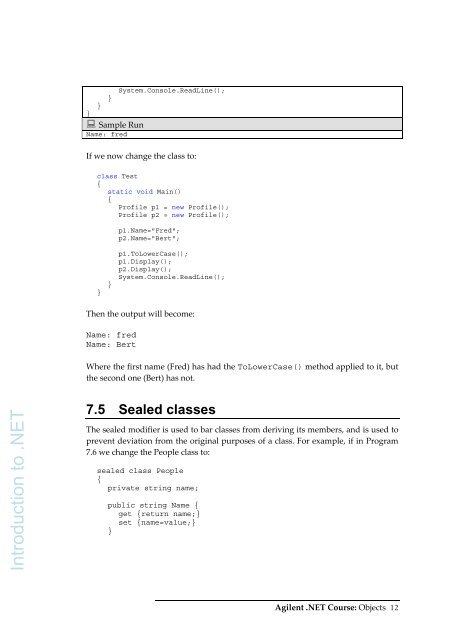Complete set: Intro to C - Bill Buchanan
Complete set: Intro to C - Bill Buchanan
Complete set: Intro to C - Bill Buchanan
You also want an ePaper? Increase the reach of your titles
YUMPU automatically turns print PDFs into web optimized ePapers that Google loves.
System.Console.ReadLine();<br />
}<br />
}<br />
}<br />
Sample Run<br />
Name: fred<br />
If we now change the class <strong>to</strong>:<br />
class Test<br />
{<br />
static void Main()<br />
{<br />
Profile p1 = new Profile();<br />
Profile p2 = new Profile();<br />
p1.Name="Fred";<br />
p2.Name="Bert";<br />
}<br />
}<br />
p1.ToLowerCase();<br />
p1.Display();<br />
p2.Display();<br />
System.Console.ReadLine();<br />
Then the output will become:<br />
Name: fred<br />
Name: Bert<br />
Where the first name (Fred) has had the ToLowerCase() method applied <strong>to</strong> it, but<br />
the second one (Bert) has not.<br />
duction <strong>to</strong> .NET<br />
<strong>Intro</strong><br />
7.5 Sealed classes<br />
The sealed modifier is used <strong>to</strong> bar classes from deriving its members, and is used <strong>to</strong><br />
prevent deviation from the original purposes of a class. For example, if in Program<br />
7.6 we change the People class <strong>to</strong>:<br />
sealed class People<br />
{<br />
private string name;<br />
public string Name {<br />
get {return name;}<br />
<strong>set</strong> {name=value;}<br />
}<br />
Agilent .NET Course: Objects 12










![Unit 5. Switches and VLANs [PDF]](https://img.yumpu.com/34422504/1/184x260/unit-5-switches-and-vlans-pdf.jpg?quality=85)





